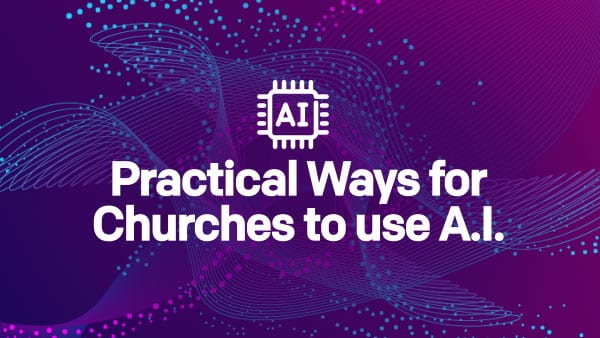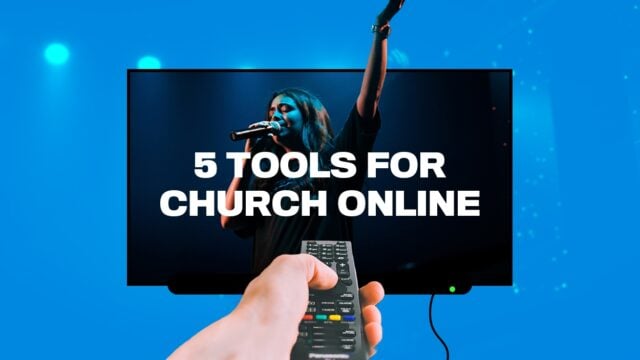
Practical Ways for Churches to Use AI
In an era driven by technological advancements, the mention of artificial intelligence (AI) can evoke mixed feelings among many, including those within the church community. Some may find the concept overwhelming, while others may even view it with skepticism or fear. However, it is essential to recognize that embracing AI can unlock tremendous potential to enhance the workload of those responsible for communications in their church.
Leveraging AI tools to improve church communications tasks might feel overwhelming, particularly if you’re not pretty tech-savvy. The reality is that AI has become increasingly accessible and user-friendly, opening up a world of possibilities. Let’s be clear: AI cannot replace humans when it comes to ministry, spirituality, and the essence of what we do as the church. However, when utilized thoughtfully, AI becomes an invaluable assistant, allowing church leaders to focus on what truly matters: fostering spiritual growth, ministering to their members, and creating meaningful connections.
With that in mind, let’s dive into the world of AI-assisted communication for small churches, discovering the opportunities it presents and unveiling the incredible potential it holds for enriching your ministry. By embracing the power of AI, we can confidently navigate the future of church communication, reaping the benefits it brings and continuing to spread the message of faith with greater effectiveness than ever before.
1. SERMONS
While writing the sermon is an intensely personal and spirit-led process that shouldn’t be outsourced to AI, there are elements of
the sermon preparation process where you or your pastor can use AI to help make the sermon prep process quicker and more effective. After all, many pastors at large churches have the luxury of a research assistant. AI is leveling the playing field with help such as these…
-
Title Ideas: AI-based content generation tools like ChatGPT, Frase, or Headline can suggest catchy sermon titles based on input prompts.
-
Illustrations: AI platforms like the ones mentioned above can also help generate stories, jokes, or other types of illustrations to help speed up sermon writing.
-
Research & Scripture Cross-Reference: Bible study software like Logos Bible Software or BibleHub can provide AI-driven cross-referencing capabilities, helping pastors find relevant verses and references quickly.
-
Summaries: AI transcription tools such as Otter.ai or Rev.ai can automatically generate written summaries of sermons or messages. These are great for blog posts, social media, or other content uses of the sermon.
2. CONTENT
-
Social Media Content: AI-powered tools like Lately or Buffer can assist in generating and scheduling engaging social media posts based on church events, sermon highlights, or inspirational quotes.
-
Newsletter Content: AI content generation tools like Article Forge or Conversion.ai can provide ideas and even draft content for church newsletters.
-
Devotional Content: AI-powered systems like ChatGPT can help you put together devotionals and Bible reading programs, and reading plans. You can also use AI to help you find stories, illustrations, etc., to include in devotionals for your congregation.
-
Editing and Proofreading: AI tools can help edit your written content and proofread for grammatical and spelling errors. If you have multiple volunteer writers on your team, AI can edit their various works to make them all speak with a consistent voice and style.
3. ARTWORK
-
Sermon Artwork: Tools like Midjourney can create custom artwork from text prompts for your sermon artwork. Combine AI-generated art with graphic design tools like Adobe Photoshop or Canva (which also have AI-powered features for automated image enhancement, background removal, or smart resizing) and you can supercharge your sermon artwork.
-
Social Media Artwork: Similar to the above, you can use AI art generators to create art for your social media channels. You can also use AI tools to resize artwork for social, and other repetitive tasks required to get your graphics ready to use for social.
-
Kids Ministry Artwork: One of our favorite uses of AI-powered illustration tools is to create coloring sheets, handouts, and other materials for children’s ministry. Tools like Artbreeder or DeepArt.io can generate unique and creative artwork suitable for kids’ ministry materials.
4. WEBSITE
Most people don’t know this, but many AI tools, such as ChatGPT, can write code and scripts for you. Here are some of our favorite website uses for ChatGPT.
-
Artwork: You can use AI art generators to create artwork, photos, and more for your website.
-
Coding: AI platforms like OpenAI’s Codex or DeepCode can assist with generating code snippets or providing coding suggestions for website development or customization.
-
Specialized Tasks: AI automation tools like Zapier or Integromat can help automate specialized tasks, such as sending email notifica- tions, updating databases, or integrating with other web services.
-
Chatbots: Chatbot platforms like Chatfuel or Dialogflow can be used to create AI-powered chatbots that handle routine tasks, provide information, or direct inquiries until a human response is available.
5. VIDEO EDITING
AI-enabled video editing is still in the primitive stages. However, there are several tasks AI can help with that can save a substantial amount of time for church communicators responsible for video editing…
-
Editing Sermons: AI video editing tools like Magisto or Adobe Premiere Pro can automate tasks such as trimming, transitions, and captioning, making the sermon editing process more efficient.
-
Sermon Clipping: AI tools like Video Indexer by Microsoft Azure or Google Cloud Video Intelligence can assist in automatically segmenting and indexing sermon videos based on keywords or specific topics.
Embracing AI is not about replacing the human touch but enhancing it. By utilizing AI tools and technologies, communications directors can alleviate their workload, streamline processes, and create more meaningful connections with their congregations.
From sermon support and content creation to artwork and website management, the five points above serve as practical starting points for incorporating AI into your church’s communication strategy. These ideas, rooted in the power of AI, are meant to inspire you to explore the possibilities and adapt them to suit your church’s unique needs and goals.




